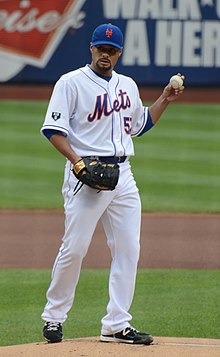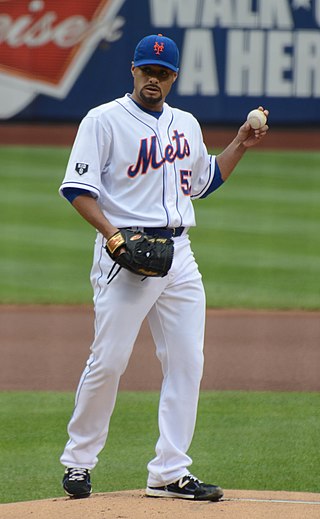
Johan Alexander Santana Araque is a Venezuelan former professional baseball starting pitcher. Santana pitched in Major League Baseball (MLB) for the Minnesota Twins from 2000 to 2007 and for the New York Mets from 2008 to 2012. A two-time Cy Young Award winner with the Twins, Santana is a four-time All-Star and earned a pitching triple crown in 2006. On June 1, 2012, Santana pitched the first no-hitter in New York Mets history against the St. Louis Cardinals.
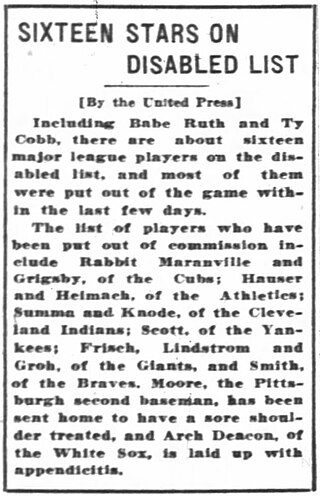
In Major League Baseball (MLB), the injured list (IL) is a method for teams to remove their injured players from the roster in order to summon healthy players. Before the 2019 season, it was known as the disabled list (DL).

Ervin Ramon Santana is a Dominican former professional baseball pitcher. He played in Major League Baseball for the Los Angeles Angels of Anaheim, Kansas City Royals (twice), Atlanta Braves, Minnesota Twins, and Chicago White Sox. Santana is a two-time All-Star, and he threw a no-hitter with the Angels in 2011.
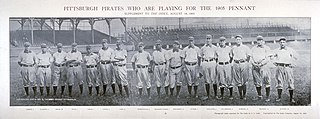
A Major League Baseball roster is a list of players who are allowed, by league agreement, to play for a Major League Baseball (MLB) team. Each MLB team maintains two rosters: an active roster of players eligible to participate in an MLB game, and an expanded roster encompassing the active roster plus additional reserve players.
Major League Baseball transactions are changes made to the roster of a major league team during or after the season. They may include waiving, releasing, and trading players, as well as assigning players to minor league teams.

The Major League Baseball draft is the primary mechanism of Major League Baseball (MLB) for assigning amateur baseball players from high schools, colleges, and other amateur baseball clubs to its teams. The draft order is determined based on a lottery where the teams who did not make the postseason in the past year participate in a state-lottery style process to determine the first six picks, starting in 2023. The team possessing the worst record receives the best odds of receiving the first pick. Until 2022, it was determined by the previous season's standings, with the worst team selecting first.
The injured reserve list is a designation used in North American professional sports leagues for athletes who suffer injuries and become unable to play. The exact name of the list varies by league; it is known as "injured reserve" in the National Football League (NFL) and National Hockey League (NHL), the "injured list" in the Canadian Football League (CFL), and the injured list in Major League Baseball (MLB). The National Basketball Association (NBA) does not have a direct analog to an injured reserve list, instead using a more general-purpose "inactive list" that does not require a player to be injured.

Designated for assignment (DFA) is a contractual term used in Major League Baseball (MLB). A player who is designated for assignment is immediately removed from the team's 40-man roster, after which the team must, within seven days, return the player to the 40-man roster, place the player on waivers, trade the player, release the player, or "send outright" the player from the 40-man roster into Minor League Baseball.
The Minnesota Twins complied a record of 69–93 during the 2000 Major League Baseball season. It was the team's last of a consecutive string record of eight losing seasons and it was characterized with weak hitting but slightly better pitching. The team was managed by Tom Kelly and contained the nucleus of future manager Ron Gardenhire's team that would reach the postseason only two years later.
Below are select minor league players and the rosters of the minor league affiliates of the Baltimore Orioles:
Below are select minor league players of the San Diego Padres organization and the rosters of their minor league affiliates:

Class A Short Season was a level of play in Minor League Baseball in the United States from 1965 through 2020. In the hierarchy of minor league classifications, it was below Triple-A, Double-A, Class A-Advanced, and Class A. Teams in Class A Short Season played about 75 to 80 games per season, compared to the 130- to 140-game seasons of most professional baseball minor leagues.
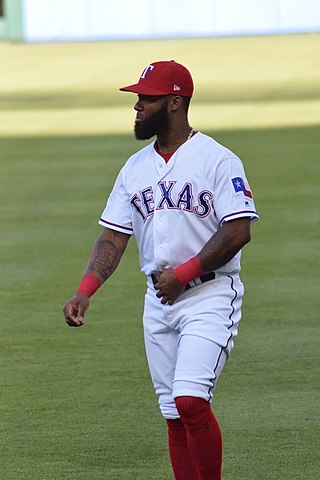
Daniel Ernesto Santana is a Dominican professional baseball infielder and outfielder who is currently a free agent. He has previously played in Major League Baseball (MLB) for the Minnesota Twins, Atlanta Braves, Texas Rangers, and Boston Red Sox.

Minor League Baseball (MiLB) is a professional baseball organization below Major League Baseball (MLB), including teams affiliated with MLB clubs.

Ronnie Silas Dawson Jr. is an American professional baseball outfielder for the Kiwoom Heroes of the KBO League. The Houston Astros selected him with the 62nd overall selection of the 2016 MLB draft. He has previously played in Major League Baseball (MLB) for the Astros and Cincinnati Reds.
Brandon Sean Michael Brennan is an American professional baseball pitcher for the Fubon Guardians of the Chinese Professional Baseball League (CPBL). He has previously played in Major League Baseball (MLB) for the Seattle Mariners and Boston Red Sox.

The 2022 Major League Baseball draft took place on July 17–19, 2022, in Los Angeles. The draft assigned amateur baseball players to Major League Baseball (MLB) teams. The draft order was based on the reverse order of the 2021 MLB season standings. In addition, compensation picks were distributed for players who did not sign from the 2021 MLB Draft.

The 2022 Detroit Tigers season was the team's 122nd season and the 23rd at Comerica Park. This was the Tigers' second season under manager A. J. Hinch. Opening Day was held on April 8 and they hosted their divisional rival, the Chicago White Sox and the season ended on the road against the Seattle Mariners on October 5. The team wore KB patches in honor of former Tigers player and coach Kimera Bartee who died on December 20, 2021, at the age of 49.

The 2022 Washington Nationals season was the Nationals' 18th season as the baseball franchise of Major League Baseball in the District of Columbia, the 15th season at Nationals Park, and the 54th since the original team was started in Montreal, Quebec, Canada. The Nationals failed to improve on their 65–97 record from the previous year, losing 107 games, having the worst record in the major leagues for the first time since 2009. The 107 losses came just three years after their first World Series title in 2019. It also marked the first time since 2009 that the Nationals lost 100 or more games in one season. In addition, it is the fifth time in franchise history that the Nationals lost 100 or more games, along with 1969, 1976, 2008, and 2009. To further add to Washington's dismal season, Juan Soto, along with Josh Bell, left the team via a trade to the San Diego Padres during the trade deadline.
Free agency in Major League Baseball (MLB) concerns players whose contracts with a team have expired and who are therefore eligible to sign with another team. Free agents may be eligible for pendulum arbitration, also called "salary arbitration" or just "arbitration" in baseball circles.
